Vitchyr Pong
OpenAI o1 System Card
Dec 21, 2024



Abstract:The o1 model series is trained with large-scale reinforcement learning to reason using chain of thought. These advanced reasoning capabilities provide new avenues for improving the safety and robustness of our models. In particular, our models can reason about our safety policies in context when responding to potentially unsafe prompts, through deliberative alignment. This leads to state-of-the-art performance on certain benchmarks for risks such as generating illicit advice, choosing stereotyped responses, and succumbing to known jailbreaks. Training models to incorporate a chain of thought before answering has the potential to unlock substantial benefits, while also increasing potential risks that stem from heightened intelligence. Our results underscore the need for building robust alignment methods, extensively stress-testing their efficacy, and maintaining meticulous risk management protocols. This report outlines the safety work carried out for the OpenAI o1 and OpenAI o1-mini models, including safety evaluations, external red teaming, and Preparedness Framework evaluations.
MURAL: Meta-Learning Uncertainty-Aware Rewards for Outcome-Driven Reinforcement Learning
Jul 18, 2021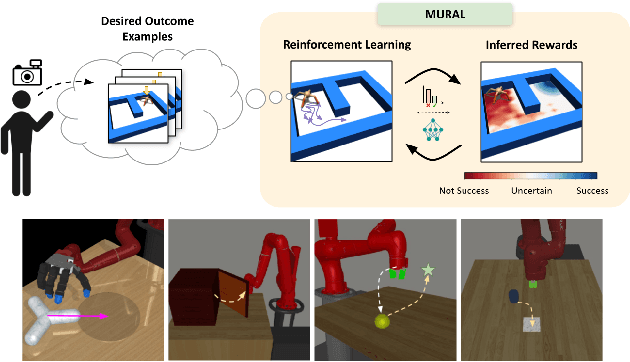
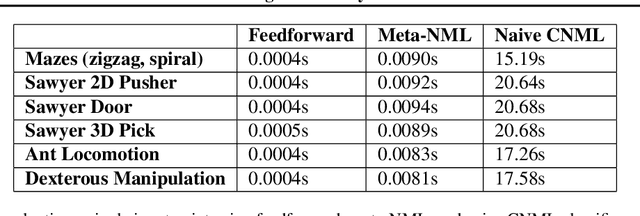


Abstract:Exploration in reinforcement learning is a challenging problem: in the worst case, the agent must search for high-reward states that could be hidden anywhere in the state space. Can we define a more tractable class of RL problems, where the agent is provided with examples of successful outcomes? In this problem setting, the reward function can be obtained automatically by training a classifier to categorize states as successful or not. If trained properly, such a classifier can provide a well-shaped objective landscape that both promotes progress toward good states and provides a calibrated exploration bonus. In this work, we show that an uncertainty aware classifier can solve challenging reinforcement learning problems by both encouraging exploration and provided directed guidance towards positive outcomes. We propose a novel mechanism for obtaining these calibrated, uncertainty-aware classifiers based on an amortized technique for computing the normalized maximum likelihood (NML) distribution. To make this tractable, we propose a novel method for computing the NML distribution by using meta-learning. We show that the resulting algorithm has a number of intriguing connections to both count-based exploration methods and prior algorithms for learning reward functions, while also providing more effective guidance towards the goal. We demonstrate that our algorithm solves a number of challenging navigation and robotic manipulation tasks which prove difficult or impossible for prior methods.
Contextual Imagined Goals for Self-Supervised Robotic Learning
Oct 23, 2019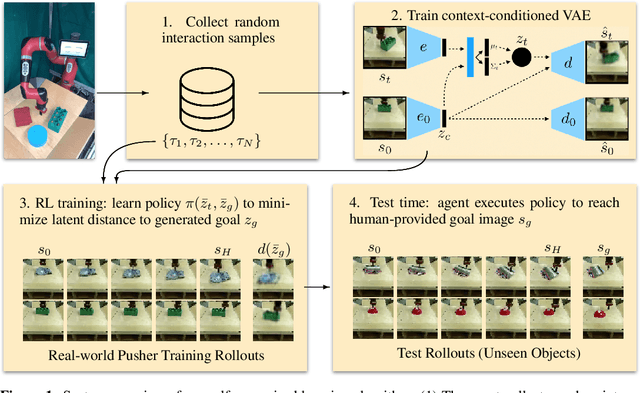

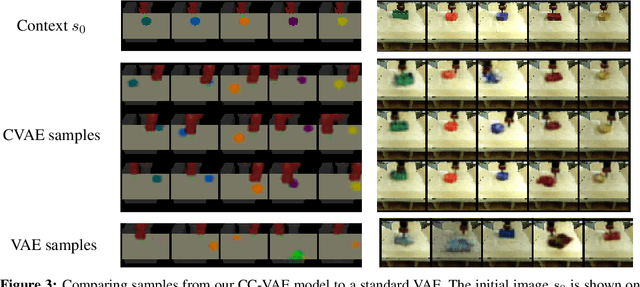
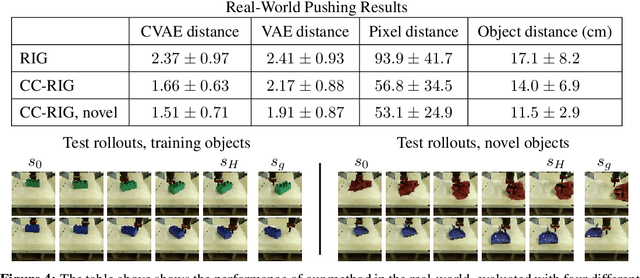
Abstract:While reinforcement learning provides an appealing formalism for learning individual skills, a general-purpose robotic system must be able to master an extensive repertoire of behaviors. Instead of learning a large collection of skills individually, can we instead enable a robot to propose and practice its own behaviors automatically, learning about the affordances and behaviors that it can perform in its environment, such that it can then repurpose this knowledge once a new task is commanded by the user? In this paper, we study this question in the context of self-supervised goal-conditioned reinforcement learning. A central challenge in this learning regime is the problem of goal setting: in order to practice useful skills, the robot must be able to autonomously set goals that are feasible but diverse. When the robot's environment and available objects vary, as they do in most open-world settings, the robot must propose to itself only those goals that it can accomplish in its present setting with the objects that are at hand. Previous work only studies self-supervised goal-conditioned RL in a single-environment setting, where goal proposals come from the robot's past experience or a generative model are sufficient. In more diverse settings, this frequently leads to impossible goals and, as we show experimentally, prevents effective learning. We propose a conditional goal-setting model that aims to propose goals that are feasible from the robot's current state. We demonstrate that this enables self-supervised goal-conditioned off-policy learning with raw image observations in the real world, enabling a robot to manipulate a variety of objects and generalize to new objects that were not seen during training.
REPLAB: A Reproducible Low-Cost Arm Benchmark Platform for Robotic Learning
May 17, 2019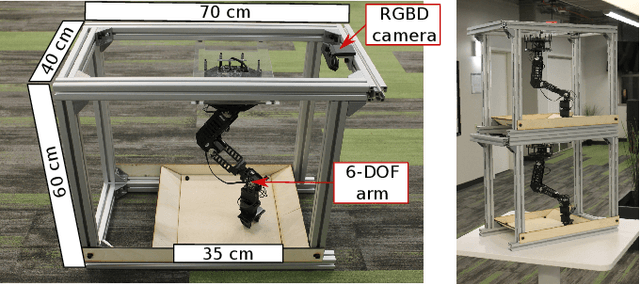

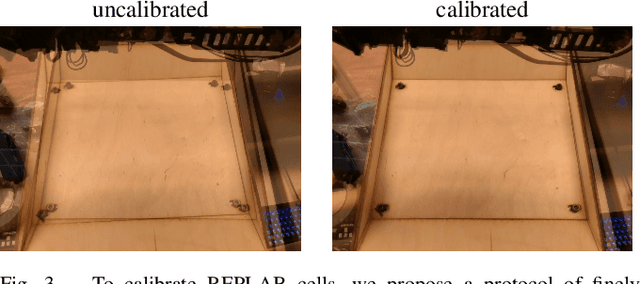

Abstract:Standardized evaluation measures have aided in the progress of machine learning approaches in disciplines such as computer vision and machine translation. In this paper, we make the case that robotic learning would also benefit from benchmarking, and present the "REPLAB" platform for benchmarking vision-based manipulation tasks. REPLAB is a reproducible and self-contained hardware stack (robot arm, camera, and workspace) that costs about 2000 USD, occupies a cuboid of size 70x40x60 cm, and permits full assembly within a few hours. Through this low-cost, compact design, REPLAB aims to drive wide participation by lowering the barrier to entry into robotics and to enable easy scaling to many robots. We envision REPLAB as a framework for reproducible research across manipulation tasks, and as a step in this direction, we define a template for a grasping benchmark consisting of a task definition, evaluation protocol, performance measures, and a dataset of 92k grasp attempts. We implement, evaluate, and analyze several previously proposed grasping approaches to establish baselines for this benchmark. Finally, we also implement and evaluate a deep reinforcement learning approach for 3D reaching tasks on our REPLAB platform. Project page with assembly instructions, code, and videos: https://goo.gl/5F9dP4.
Visual Reinforcement Learning with Imagined Goals
Dec 04, 2018

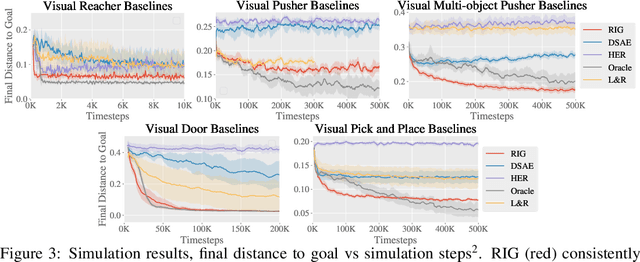
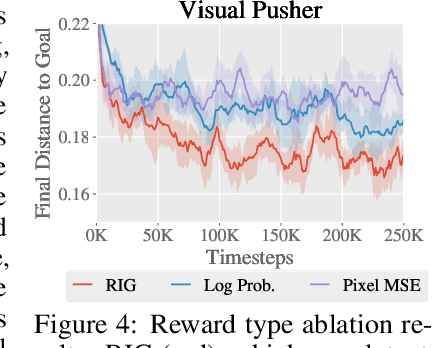
Abstract:For an autonomous agent to fulfill a wide range of user-specified goals at test time, it must be able to learn broadly applicable and general-purpose skill repertoires. Furthermore, to provide the requisite level of generality, these skills must handle raw sensory input such as images. In this paper, we propose an algorithm that acquires such general-purpose skills by combining unsupervised representation learning and reinforcement learning of goal-conditioned policies. Since the particular goals that might be required at test-time are not known in advance, the agent performs a self-supervised "practice" phase where it imagines goals and attempts to achieve them. We learn a visual representation with three distinct purposes: sampling goals for self-supervised practice, providing a structured transformation of raw sensory inputs, and computing a reward signal for goal reaching. We also propose a retroactive goal relabeling scheme to further improve the sample-efficiency of our method. Our off-policy algorithm is efficient enough to learn policies that operate on raw image observations and goals for a real-world robotic system, and substantially outperforms prior techniques.
Composable Deep Reinforcement Learning for Robotic Manipulation
Mar 19, 2018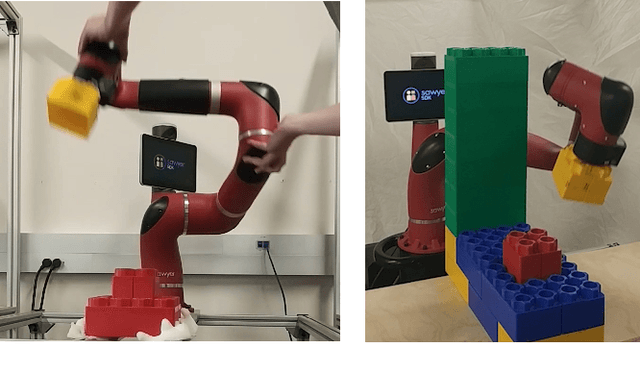
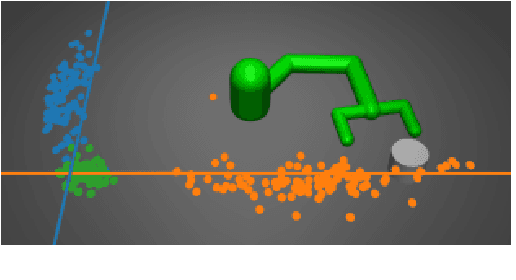
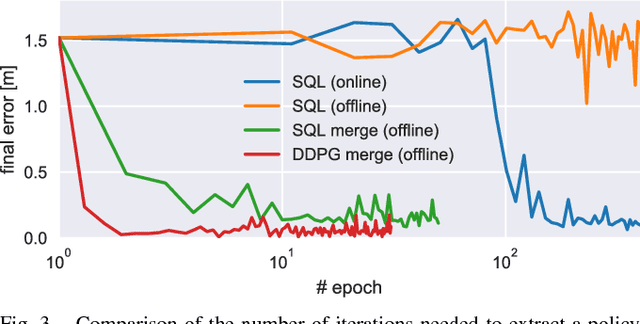
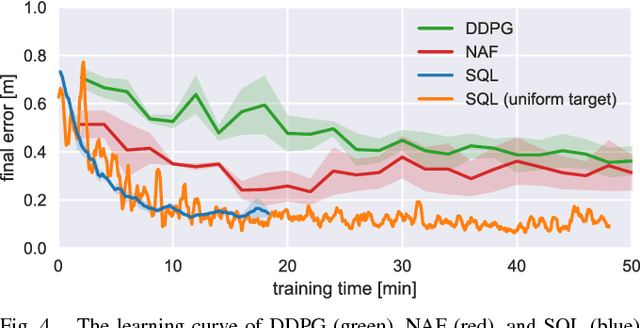
Abstract:Model-free deep reinforcement learning has been shown to exhibit good performance in domains ranging from video games to simulated robotic manipulation and locomotion. However, model-free methods are known to perform poorly when the interaction time with the environment is limited, as is the case for most real-world robotic tasks. In this paper, we study how maximum entropy policies trained using soft Q-learning can be applied to real-world robotic manipulation. The application of this method to real-world manipulation is facilitated by two important features of soft Q-learning. First, soft Q-learning can learn multimodal exploration strategies by learning policies represented by expressive energy-based models. Second, we show that policies learned with soft Q-learning can be composed to create new policies, and that the optimality of the resulting policy can be bounded in terms of the divergence between the composed policies. This compositionality provides an especially valuable tool for real-world manipulation, where constructing new policies by composing existing skills can provide a large gain in efficiency over training from scratch. Our experimental evaluation demonstrates that soft Q-learning is substantially more sample efficient than prior model-free deep reinforcement learning methods, and that compositionality can be performed for both simulated and real-world tasks.
Temporal Difference Models: Model-Free Deep RL for Model-Based Control
Feb 25, 2018
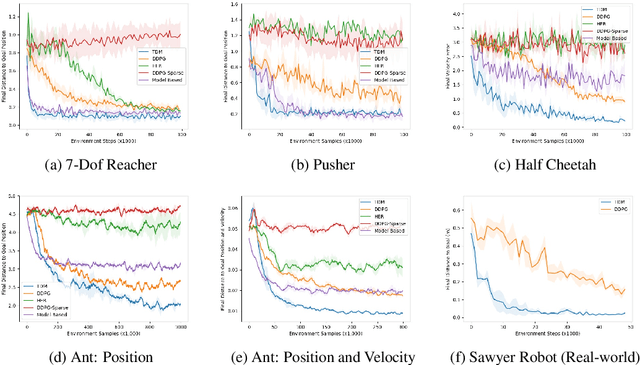
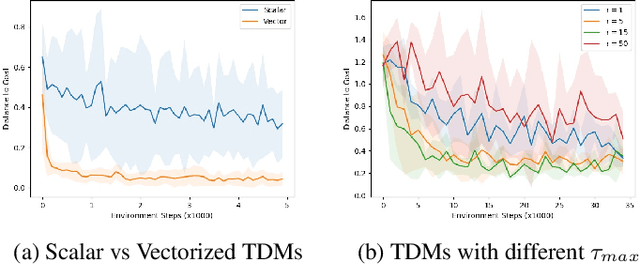
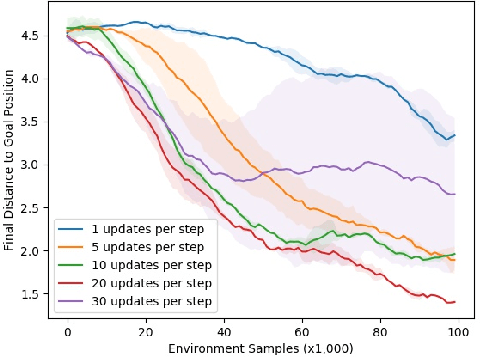
Abstract:Model-free reinforcement learning (RL) is a powerful, general tool for learning complex behaviors. However, its sample efficiency is often impractically large for solving challenging real-world problems, even with off-policy algorithms such as Q-learning. A limiting factor in classic model-free RL is that the learning signal consists only of scalar rewards, ignoring much of the rich information contained in state transition tuples. Model-based RL uses this information, by training a predictive model, but often does not achieve the same asymptotic performance as model-free RL due to model bias. We introduce temporal difference models (TDMs), a family of goal-conditioned value functions that can be trained with model-free learning and used for model-based control. TDMs combine the benefits of model-free and model-based RL: they leverage the rich information in state transitions to learn very efficiently, while still attaining asymptotic performance that exceeds that of direct model-based RL methods. Our experimental results show that, on a range of continuous control tasks, TDMs provide a substantial improvement in efficiency compared to state-of-the-art model-based and model-free methods.
Uncertainty-Aware Reinforcement Learning for Collision Avoidance
Feb 03, 2017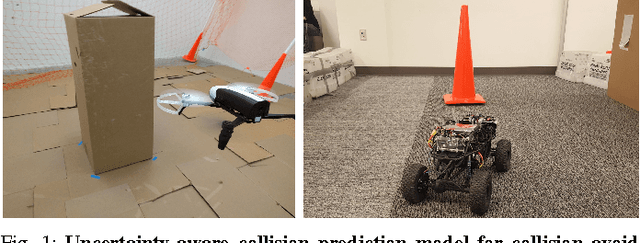

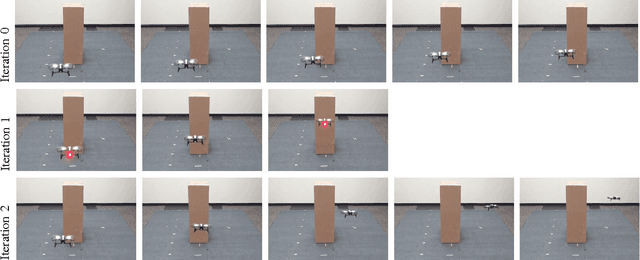
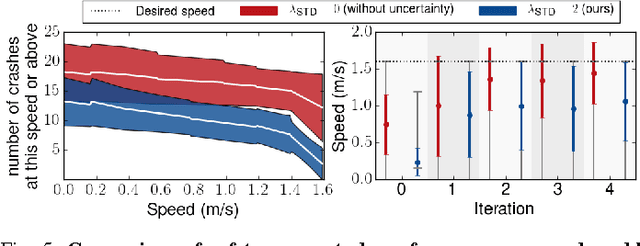
Abstract:Reinforcement learning can enable complex, adaptive behavior to be learned automatically for autonomous robotic platforms. However, practical deployment of reinforcement learning methods must contend with the fact that the training process itself can be unsafe for the robot. In this paper, we consider the specific case of a mobile robot learning to navigate an a priori unknown environment while avoiding collisions. In order to learn collision avoidance, the robot must experience collisions at training time. However, high-speed collisions, even at training time, could damage the robot. A successful learning method must therefore proceed cautiously, experiencing only low-speed collisions until it gains confidence. To this end, we present an uncertainty-aware model-based learning algorithm that estimates the probability of collision together with a statistical estimate of uncertainty. By formulating an uncertainty-dependent cost function, we show that the algorithm naturally chooses to proceed cautiously in unfamiliar environments, and increases the velocity of the robot in settings where it has high confidence. Our predictive model is based on bootstrapped neural networks using dropout, allowing it to process raw sensory inputs from high-bandwidth sensors such as cameras. Our experimental evaluation demonstrates that our method effectively minimizes dangerous collisions at training time in an obstacle avoidance task for a simulated and real-world quadrotor, and a real-world RC car. Videos of the experiments can be found at https://sites.google.com/site/probcoll.
 Add to Chrome
Add to Chrome Add to Firefox
Add to Firefox Add to Edge
Add to Edge